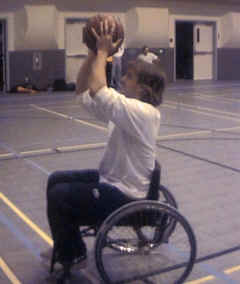Shooting

Shooting

One of the more difficult skills to learn in wheelchair basketball is shooting. This is because the trajectory of the ball from the point of the origin to the basket is much larger than in able-bodied basketball. Although many of the arm and hand movements involved in the shooting technique are the same as in able-bodied basketball, there are a few differences which can make a considerable impact upon an individual's game performance.
Upper body strength is a general criterion needed for shooting. This is because the point of departure of the shot occurs at a much lower level in wheelchair basketball than in able-bodied basketball in order to achieve the needed trajectory to reach the basket and in order to maintain chair stability. In able-bodied basketball the shot is normally started from approximately shoulder-height whereas in wheelchair basketball the shot starts from as low as waist-height.
One of the other main differences in shooting between the two types of basketball is in the follow-through. In able-bodied basketball follow-through is only sustained through to the complete flexion of the hand at the wrist. In wheelchair basketball full and complete arm extension is vital in order to provide the most forceful, advantageous, and consistent trajectory to the basket. It is this follow-through that makes the largest difference in shooting from mid and long-range distances.
As mentioned previously the chair is considered to be a part of the player for all contact and boundary violations, this rule can be used to the advantage of the shooter as the foot platforms of the chair can act as a shield between the shooter and the defender. This shield can work well when directly facing the basket as it may prevent the defender from blocking the shot.
Analysis of Shooting Technique
Once arm is fully extended follow-through with extension of the hand at the wrist, releasing the ball at full extension
Complete the follow-through with complete flexion of the hand at the wrist so that fingers are now pointing toward the floor

Classification of Shooting
Various classifications of motor skills have been developed so as to be able to evaluate the motor skill and to determine appropriate approaches to treatment activities.
One example of a classification system is Gentile's Two-Dimensional Taxonomy. It is considered to be two-dimensional as it considers not only the requirements of the action but also the demands of the environment. The four variables that are considered in the classification are whether the body is stable or in motion, if an object is manipulated, whether the environment's regulatory conditions are stationary or in motion, and if there is inter-trial variability. According to Gentile's Taxonomy of skills, shooting in a game situation is considered to be a 16 on a level of 1-16 due to the fact that the body is in transport, an object (the basketball) is manipulated, there are regulatory conditions in motion and there is inter-trial variability.
Shooting can also be classified as a discrete skill as it has a defined beginning and end and is brief in duration.
Yet another
way to classify the motor skill of shooting is by defining it as an open
skill as the player must adjust his or her shot in response to changes
in the environment.
Home |Paraplegia| Shooting | Evaluation of Learning